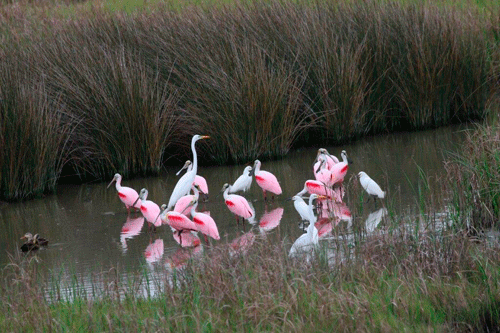
Roseate spoonbills with great egrets and snowy egrets and a pair of ducks on the road just outside of Port Lavaca on the way to Port O’Connor.
-Photo by R. Patrick Wood
The Texas pink flamingos. Those big pink birds. Huge, bright, long legged birds with that weird big spoon shaped bill. For ages people living on the coast or visiting for the weekend have claimed to see flamingos up and down our Texas coast. They are big and bright alright. Definitely pink, but they are not flamingos. Our pink birds are Roseate Spoonbills. They are in the large group of birds we call wading birds. They live along the entire Texas coast, and at times wander a few miles inland using freshwater ponds. You will normally find them feeding along shallow coastal wetlands or along bay shorelines.
The Roseate Spoonbill’s spatulate-shaped bill is specially adopted to feed in shallow waters, moving their head and bill in sweeping motions side to side. As the bill moves it is detecting small prey by feel, and strains any food items out of the water. Their diet consists of mostly small fish and aquatic invertebrates, such as minnows and killifish, but also shrimp, crayfish, crabs, aquatic insects, mollusks, and some slugs. They may also at times forage on some plant material, including roots and stems of the common sedges. The bright pink plumage color comes from the carotene found in their prey items such as shrimp.
Today spoonbills are doing relatively ok, but are vulnerable to changes or destruction to their feeding and nesting habitats along the coast. The North American Waterbird Conservation Plan estimated a continental population of 20,500 breeding birds in 2014. Any changes to their breeding sites by human activity can easily affect population numbers. Climate change affecting sea water levels can also do the same. In the 1800’s spoonbills were almost wiped out in the United States by people hunting birds for feathers used in women’s hats and decorations. Entire nesting colonies were destroyed. The birds have since made a recovery thanks to decades of protection. Mother Nature is resilient if she is left alone!
These birds can have an average wingspan of 49” and weigh an average of 50 oz. They nest in large colonies in small trees or shrubs on coastal islands and shorelines, often sharing the colony grounds with other heron and egrets. The large numbers of birds offer some protection from predators. Their romantic courtship starts a bit on the aggressive side, but calms down and the birds will perch closely together, presenting a stick to each other, finally crossing their bills, and then one clasps the other’s bill.
On a related side note, there is actually one real flamingo flying around our coastal area. It escaped from a zoo some years ago and moves freely up and down our coast. It towers over the spoonbills that are half its size, and is normally only seen from boats out in the bays. Our biologists here at the Gulf Coast Bird Observatory have recently spotted it while out doing shorebird surveys. Keep your eye open for those big pink birds!
